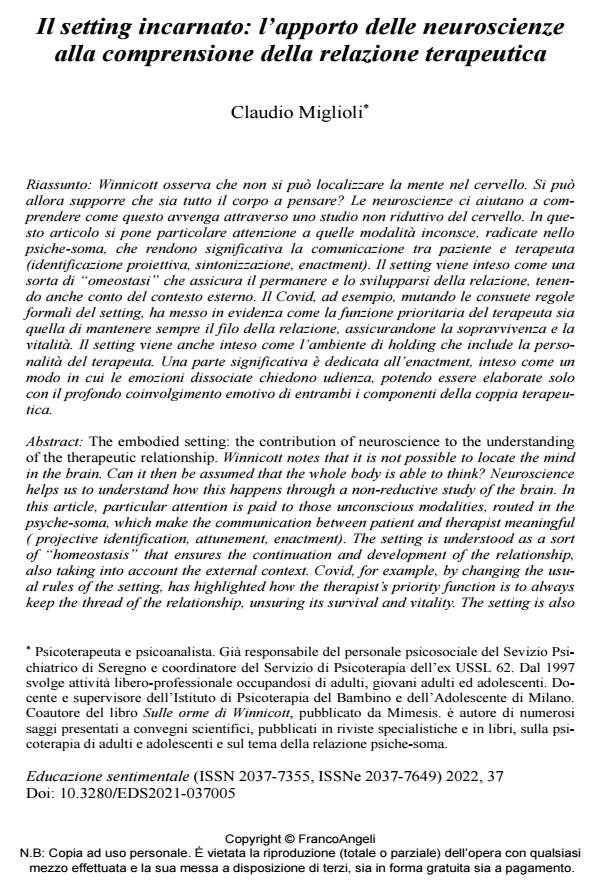Il setting incarnato: l’apporto delle neuroscienze alla comprensione della relazione terapeutica
Journal title EDUCAZIONE SENTIMENTALE
Author/s Claudio Miglioli
Publishing Year 2022 Issue 2022/37
Language Italian Pages 18 P. 58-75 File size 219 KB
DOI 10.3280/EDS2022-037005
DOI is like a bar code for intellectual property: to have more infomation
click here
Below, you can see the article first page
If you want to buy this article in PDF format, you can do it, following the instructions to buy download credits

FrancoAngeli is member of Publishers International Linking Association, Inc (PILA), a not-for-profit association which run the CrossRef service enabling links to and from online scholarly content.
The embodied setting: the contribution of neuroscience to the understanding of the therapeutic relationship. Winnicott notes that it is not possible to locate the mind in the brain. Can it then be assumed that the whole body is able to think? Neuro-science helps us to understand how this happens through a non-reductive study of the brain. In this article, particular attention is paid to those unconscious modali-ties, routed in the psyche-soma, which make the communication between patient and therapist meaningful ( projective identification, attunement, enactment). The setting is understood as a sort of "homeostasis" that ensures the continuation and development of the relationship, also taking into account the external con-text. Covid, for example, by changing the usual rules of the setting, has highlight-ed how the therapist’s priority function is to always keep the thread of the rela-tionship, unsuring its survival and vitality. The setting is also understood as the holding environment that includes the therapist’s personality. A significant part is dedicated to enactment, understood as a way in which the dissociated emotions ask for an audience, being able to be elaborated only with the deep emotional involvement of both members of the therapeutic couple.
Keywords: to go on being, homeostasis, dissociated states of the Self, intersubjec-tivity, attunement, vital feelings, enactment, internal setting of the therapist.
- Amati Sas S. (2020). Ambiguità, conformismo e adattamento alla violenza sociale. Milano: Franco Angeli.
- Benjamin J. (2019). Il riconoscimento reciproco. Milano: Cortina, 2019.
- Bromberg Ph. M. (1998/2001). Clinica del trauma e della dissociazione. Milano: Cortina, 2007.
- Bromberg Ph. M. (2006). Destare il sognatore. Milano: Cortina, 2009.
- Bromberg Ph. M. (2011). L’ombra dello tsunami. Milano: Cortina, 2012.
- Damasio A.R. (1999). Emozione e coscienza. Milano: Adelphi, 2000.
- Damasio A.R. (2018). Lo strano ordine delle cose. Milano: Adelphi, 2018.
- Freud S. (1915-17). Introduzione alla psicoanalisi. O.S.F. Vol. 8. Torino: Boringhieri.
- Hustvedt S.(2016). Le illusioni della certezza. Torino: Einaudi, 2018.
- Miglioli C., Roseghini R. (2012). Sulle orme di Winnicott. Milano-Udine: Mimesis.
- Nucci M. (2013). Le lacrime degli eroi. Torino: Einaudi.
- Ogden T. (1991). L’identificazione proiettiva e la tecnica psicoterapeutica. Roma: Astrolabio, 1994.
- Ogden T. (2003). Conversazioni al confine del sogno. Roma: Astrolabio, 2003.
- Ogden T. (2005). L’arte della psicoanalisi. Milano: Cortina, 2008.
- Ogden T. (2016). Vite non vissute. Milano: Cortina, 2016.
- Omnis L., a cura di (2015). Una nuova alleanza tra psicoterapia e neuroscienze. Dall’intersoggettività ai neuroni specchio. Dialogo tra Daniel Stern e Vittorio Gallese. Milano: Franco Angeli.
- Sandler J., Sandler A.M (1998). Gli oggetti interni. Una rivisitazione. Milano: Franco Angeli, 2002.
- Schore A.N. (2003). La regolazione degli affetti e la riparazione del Sé. Roma: Astrolabio, 2003.
- Stern D.N. (1985). Il mondo interpersonale del bambino. Torino: Bollati Boringhieri, 1987.
- Winnicott D.W. (1949). L’intelletto ed il suo rapporto con lo psiche-soma. In: Dalla pediatria alla psicoanalisi. Firenze: Martinelli, 1975.
- Winnicott D.W. (1962). Comunicare e non comunicare: studi su alcuni opposti. In: Sviluppo affettivo e ambiente. Roma: Armando, 1970.
Claudio Miglioli, Il setting incarnato: l’apporto delle neuroscienze alla comprensione della relazione terapeutica in "EDUCAZIONE SENTIMENTALE" 37/2022, pp 58-75, DOI: 10.3280/EDS2022-037005